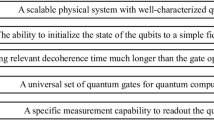Abstract
The paper surveys how chemistry has developed over the past two centuries starting from Lavoisier’s classification of the chemical elements at the end of the eighteenth century; the subsequent development of the atomic–molecular model of matter preoccupied chemists throughout the nineteenth century, while the results of the application of quantum theory to the molecular model has been the story of this century. Whereas physical chemistry originated in the nineteenth century with the measurement of the physical properties of groups of chemical compounds that chemists identified as families, the goal of chemical physics is the explanation of the facts of chemistry in terms of the principles and theories of physics. Chemical physics as such was only possible after the discovery of the quantum theory in the 1920’s. By then the first of the sub‐atomic particles had been discovered and seemingly it is no longer possible to discuss chemical facts purely in terms of atoms and molecules – one has to recognize the electron and the nucleus, the parts of atoms. The combination of classical molecular structure with the quantum properties of the electron has given us a tremendously successful account of chemistry called ‘quantum chemistry’. Yet from the perspective of the quantum theory the deepest part of chemistry, the existence of chemical isomers and the very idea of molecular structure that rationalizes it, remains a central problem for chemical physics.
Similar content being viewed by others
References
P.W. Anderson, Basic Notions in Condensed Matter Physics (Benjamin, Cummings, 1984).
C.J. Ballhausen, J. Chem. Ed. 56 (1979) 357.
A. Lavoisier, Traité Élémentaire de Chimie, Oeuvres de Lavoisier (Imprimerie Imperiale, Paris, 1864).
I. Prigogine and C. George, Proc. Natl. Acad. Sci. USA 80 (1983) 4590.
R.F. Streater, Statistical Dynamics (Imperial College Press, 1995).
S. Weinberg, The Quantum Theory of Fields, Vol. 1, Foundations (1995) chapters 10, 13.
R.G. Woolley, Adv. Phys. 25 (1976) 27.
R.G. Woolley, in: Molecules in Physics, Chemistry and Biology, Vol. 1, ed. J. Maruani (1988) p. 45.
R.G. Woolley, Mol. Phys. 85 (1995) 539.
R.G. Woolley, Mol. Phys. 88 (1996) 291.
Author information
Authors and Affiliations
Rights and permissions
About this article
Cite this article
Woolley, R. Is there a quantum definition of a molecule?. Journal of Mathematical Chemistry 23, 3–12 (1998). https://doi.org/10.1023/A:1019144518901
Issue Date:
DOI: https://doi.org/10.1023/A:1019144518901




